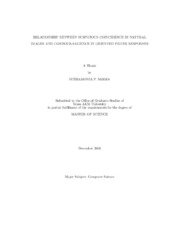| dc.description.abstract | Salient contour detection is an important lowlevel visual process in the human visual system, and has significance towards understanding higher visual and cognitive processes. Salience detection can be investigated by examining the visual cortical response to visual input. Visual response activity in the early stages of visual processing can be approximated by a sequence of convolutions of the input scene with the difference-of-Gaussian (DoG) and the oriented Gabor filters. The filtered responses are unusually high for prominent edge locations in the image, and are uniformly similar across different natural image inputs. Furthermore, such a response follows a power law distribution. The aim of this thesis is to examine how these response properties could be utilized to the problem of salience detection. First, I identify a method to find the best threshold on the response activity (orientation energy) toward the detection of salient contours: compare the response distribution to a Gaussian distribution of equal variance. Second, I justify this comparison by providing an explanation under the framework of Suspicious Coincidence proposed by Barlow [1]. A connection is provided between perceived salience of contours and the neuronal goal of detecting suspiciousness, where salient contours are seen as affording suspicious coincidences by the visual system. Finally, the neural plausibility of such a salience detection mechanism is investigated, and the representational effciency is shown which could potentially explain why the human visual system can effortlessly detect salience. | en |


